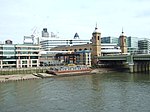Worshipful Company of Dyers
1471 establishments in EnglandGrade II* listed livery hallsLivery companiesLondon stubsOrganisations based in London with royal patronage ... and 1 more
Use British English from May 2014

The Worshipful Company of Dyers is one of the Livery Companies of the City of London. The Dyers' Guild existed in the twelfth century; it received a Royal Charter in 1471. It originated as a trade association for members of the dyeing industry but is now mainly a charitable institution. Each year the company participates in the ceremony of Swan Upping along the River Thames. The Dyers' Company ranks thirteenth in the order of precedence of Livery Companies. The company's motto is Da Gloriam Deo, Latin for "Give Glory to God".
Excerpt from the Wikipedia article Worshipful Company of Dyers (License: CC BY-SA 3.0, Authors, Images).Worshipful Company of Dyers
Dowgate Hill, City of London
Geographical coordinates (GPS) Address Nearby Places Show on map
Geographical coordinates (GPS)
| Latitude | Longitude |
|---|---|
| N 51.51096 ° | E -0.09121 ° |
Address
Dyers Hall
Dowgate Hill 10
EC4R 2ST City of London
England, United Kingdom
Open on Google Maps










